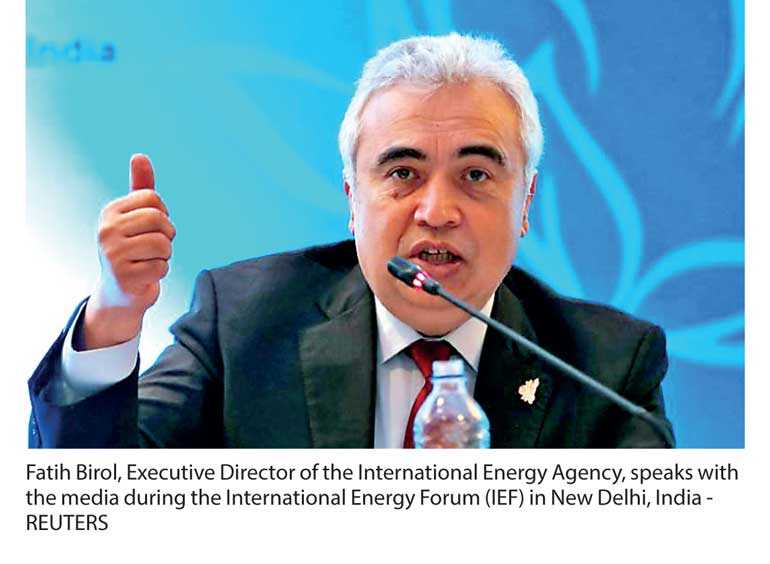Monday Mar 10, 2025
Monday Mar 10, 2025
Wednesday, 31 October 2018 00:00 - - {{hitsCtrl.values.hits}}
 SINGAPORE (Reuters): High oil prices are hurting consumers and could also have adverse implications for producers, the executive director of the International Energy Agency (IEA) said on Tuesday.
SINGAPORE (Reuters): High oil prices are hurting consumers and could also have adverse implications for producers, the executive director of the International Energy Agency (IEA) said on Tuesday.
Major emerging Asian economies such as India and Indonesia have been hit hard this year by rising crude oil prices, which despite falls this month are up by around 15% since the start of 2018.
Fuel import costs have been pushed up further by a slide in emerging market currencies against the dollar, denting growth and even triggering protests and government fuel price controls in India.
“Many countries’ current account deficits have been affected by high oil prices,” IEA chief Fatih Birol said at an energy conference in Singapore.
“There are two downward pressures on global oil demand growth. One is high oil prices, and in many countries they’re directly related to consumer prices. The second one is global economic growth momentum slowing down.”
The effect of high oil prices will be compounded in Southeast Asia as demand is rising fast but production is falling, resulting in the region becoming a net importer of oil, gas and coal, Birol said.
Despite the possibility of a slowdown, Birol said the general outlook for fuel consumption was for continued growth.
While the rise of electric vehicles is expected to result in peak demand for products like diesel and gasoline within coming years, a consumption boom in products such as plastic as well as fuel demand growth from aviation have triggered large-scale refinery investment into petrochemical products and high quality products like jet fuel.
“Global oil Demand will continue to grow even amid the rise of electric vehicles as they are governed by petrochemicals, aviation, among others,” he said.
LNG booming
More so than oil, Birol said demand for liquefied natural gas (LNG) would boom.
The IEA chief said that global LNG trade could pass 500 billion cubic metres per day (bcm) by 2023, growing by a third in the coming five years.
Birol said just three countries, Qatar, Australia and the United States, would supply 60% of global LNG by 2023.
LNG demand is primarily driven by growth in China, where an anti-pollution programme is driving a massive shift from coal to natural gas.
But demand is also expected to grow fast in Southeast Asia, where Birol said the power sector needed $50 billion of investment by 2040, more than twice the current level, to keep up with consumption.
Despite this growth potential, the LNG sector faces increasing competition from renewables and storage technology, which are cleaner than fossil fuels and becoming much cheaper.
In many countries, Birol said solar power was on track to become the cheapest source of new electricity.
Discover Kapruka, the leading online shopping platform in Sri Lanka, where you can conveniently send Gifts and Flowers to your loved ones for any event including Valentine ’s Day. Explore a wide range of popular Shopping Categories on Kapruka, including Toys, Groceries, Electronics, Birthday Cakes, Fruits, Chocolates, Flower Bouquets, Clothing, Watches, Lingerie, Gift Sets and Jewellery. Also if you’re interested in selling with Kapruka, Partner Central by Kapruka is the best solution to start with. Moreover, through Kapruka Global Shop, you can also enjoy the convenience of purchasing products from renowned platforms like Amazon and eBay and have them delivered to Sri Lanka.
Discover Kapruka, the leading online shopping platform in Sri Lanka, where you can conveniently send Gifts and Flowers to your loved ones for any event including Valentine ’s Day. Explore a wide range of popular Shopping Categories on Kapruka, including Toys, Groceries, Electronics, Birthday Cakes, Fruits, Chocolates, Flower Bouquets, Clothing, Watches, Lingerie, Gift Sets and Jewellery. Also if you’re interested in selling with Kapruka, Partner Central by Kapruka is the best solution to start with. Moreover, through Kapruka Global Shop, you can also enjoy the convenience of purchasing products from renowned platforms like Amazon and eBay and have them delivered to Sri Lanka.